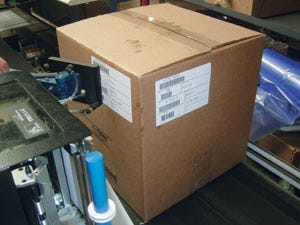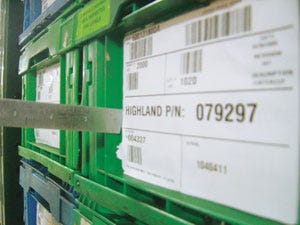Armed for precision labeling
March 11, 2015

PDX1004highlnd1
ITW Highland, Waterbury, CT, has finished a yearlong packaging line upgrade that so greatly improved the efficiency of one of its four metal parts packing lines that the majority of its packaging is now done on this updated line.As one of four businesses units within ITW Drawn Metals Group, Highland provides deep drawn and progressive metal stamping for customers in the automotive, medical, telecommunications, industrial, consumer goods and electronics industries.
The contract manufacturer produces more than 300 different products, and in a typical day can prepare and label 1,000 parts packages. For many of its customers, these parts orders can be packed in corrugated cases that Highland purchases from U.S. Corrugated Inc. One customer has embraced the reusable packaging movement though.
“This major customer wants everything in reusable totes,” says Karl Knightly, automation technician at Highland. “Every week, they send a tractor-trailer with the totes and we fill the totes up with probably 40 or 50 different parts.”
Reusable packaging benefits, challenges operations

PDX1004highlnd3
These HDPE, utility-grade plastic totes offer some logistical benefits, e.g., their consistent size and their cross-docking features, allow 30 totes to be stacked on a skid. Because the corrugated cases differ in size, a skid can contain from 20 to 40 cartons and typically averages 27 cartons, which is three fewer filled packages than a skid of totes.Unfortunately, the reusable totes present a significant packaging challenge: The labeling area for the plastic totes is recessed by 0.5 in. and doesn't allow for a lot of play in label placement. The customer who owns the totes also does not tolerate inconsistent labeling.
“With this particular tote customer, it has to be right,” remarks Knightly.
Working with limited resources
To ensure proper labeling of all packages, including these plastic totes, Highland was labeling all the totes manually. This proved to be an especially time- and labor-extensive step in the pack-out process.
“It might seem like labeling is not a big deal because it doesn't take long to grab a label and put it on a box,” Knightly explains. “But jobs that are packed with oily parts are packed by an operator wearing gloves, so the operator has to take a glove off, remove the label from the printer, place the label on the tote, and put his gloves back on.”
When Knightly joined the company in 2006, he was charged to execute a packing line improvement plan that included automating the package labeling processes. After researching different print-and-apply options on the market, one was from another Illinois Tool Works division, ITW Diagraph, but the other devices were manufactured by companies outside the ITW conglomerate of compaines.
“I just wanted to be sure that we were getting the best,” Knightly says. “This wasn't a million dollar project, but it still involved a considerable amount of money. I wanted to be sure that when it's all said and done that the machine I put on the floor worked reliably and consistently.”
He also wanted a unit with all the major components—print engine, label applicator, conveyors—already integrated.
“One of the things I really wanted was for this to be a plug-and-play type of unit,” Knightly remarks. “I could have purchased a conveyor and then try to integrate it. But we have limited resources, and I work by myself many hours in the day. Sometimes, it's easier and better if you can find a company that will do the integration for you.”
The deciding factor on this purchase ended up being something other than cold, hard metal.
Building a support team
The customer support offered by the Diagraph salesman is what ultimately sold the integrated system for Knightly.
“The salesman from Diagraph—Chris Nevin—made me feel confident that they knew what they are talking about and that they would stand behind the product,” Knightly comments. “A lot of the solutions out there are pretty similar—there's not a big difference in price. I wanted to be sure that I wasn't getting just a lot of talk.”
To ensure that he wasn't giving Knightly 'just a lot of talk,' Nevin brought in technical experts as early as the bidding process.
“I think salespeople know the systems fairly well,” says Nevin. “But for me, a key part of my service is including the technical field people because they make it happen.”
Nevin brought in two technicians straightaway: Chuck Wyke, who worked with Knightly during the design process; and Damon Neal, who took the specifications gathered in the field by Wyke and Nevin and applied them to the manufacturing and assembly process.
Three machines that work as one
The Diagraph solution utilizes three integrated machines: a Diagraph Platinum Series PA6000 FASA with a front apply swing arm and custom tamp pad; a Zebra 110 PAX 4 print engine; and a custom integrated R.L. Craig conveyor.
The custom tamp pad was important because of the tight constraints of the plastic tote's recessed labeling area. Nevin explains, “There was very little room for error—maybe a sixteenth or eighteenth of an inch.”
The system not only can place the 4 x 6-in. label with the part number, lot number, quantity, customer name, customer part number, date and bar-code on the plastic totes. It also is being used to place labels on the leading panel and the side panel of the corrugated cases.
Multiple upgrades offer multiple benefits
The print-and-apply labeling system is one of many upgrades made to the packing line. Highland replaced its 2 cu/ft hopper with a 15 cu/ft model, which often is large enough to hold a complete lot of work. The manufacturer also added a Rice-Lake checkweigher.
Commenting on the improved workflow, Knightly says, “Now we can fill level, close the box and push it through the Little David automated box taper [supplied by Loveshaw]. It goes to the labeler and it's done. It just makes it so easy.”
Knightly is so pleased with the print-and-apply labeling system that, at time of publication, he is installing a second system. The new labeling system will be installed at the end of a parts washing line.
More information is available: |
Diagraph, 800/722-1125. www.diagraph.com |
Loveshaw, an ITW Co., 800/572-3434. www.loveshaw.com |
U.S. Corrugated Inc., 973/353-8088. www.uscorr.com |
Zebra Technologies Corp., 866/230-9494. www.zebra.com |
About the Author(s)
You May Also Like


